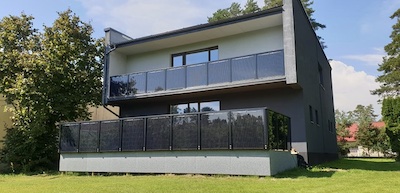Understanding Balcony Solar Systems
A balcony solar system, exemplified by a setup in Estonia utilizing Hoymiles microinverters, presents a convenient and accessible means of harnessing solar energy. This innovative approach eliminates the complexities associated with traditional solar panel systems, making it an attractive choice for property owners.

Why Opt for a Balcony Solar System?
1. Ease of Installation: Balcony solar systems, also known as plug-in solar systems, simplify installation compared to traditional setups with intricate wiring. These systems directly connect to your home's electrical circuit by plugging into a standard wall socket, typically referred to as Schuko plugs and outlets in Europe. This straightforward approach eliminates the need for costly professional panel designs and assessments, making complex installations a thing of the past.
2. Portability: Balcony solar systems are exceptionally portable. You can easily disconnect and relocate them when you move, saving you both time and money on new panels with each relocation.
3. Minimal Registration: Unlike traditional roof- or ground-mounted systems that require registration with the operator when connected to the grid, balcony solar panels often fall below this threshold. If your solar system adheres to the European upper limit standard of 800 W, registration is typically unnecessary. For Germany, this threshold may soon increase to 800 W, aligning with the European standard, simplifying access to solar energy through mini power generation systems.
The New 800 W German Standard
VDE (Verband der Elektrotechnik Elektronik Informationstechnik e.V.), one of Europe's largest technology organizations, plays a vital role in setting quality standards and ensuring consumer protection. VDE proposed raising the maximum power output for balcony solar systems in Germany to 800 W, matching the European standard. This adjustment includes enhanced testing and certification requirements to maintain specific performance standards, promoting the use of solar energy.
Components of a Balcony Solar System
A successful balcony solar PV system comprises four essential components:
1. Solar Panels: These panels capture sunlight and convert it into direct current (DC) energy, which can be further converted into usable alternating current (AC) electricity. Some systems include battery storage for surplus energy.
2. Mounting Rack: The sturdy mounting rack secures solar panels safely on the balcony, ensuring stability and durability.
3. Microinverter: Responsible for converting DC electricity from solar panels into AC electricity, microinverters maximize the efficiency of each panel, ensuring optimal performance.
4. Mains Power Cable: A unique component of balcony solar systems, the mains power cable connects the system to a wall socket, facilitating easy plug-and-play functionality.
Is Balcony Solar Worth the Investment?
If you reside in a sunny area and your property is unsuitable for traditional solar panels, a balcony solar system is a compelling investment. As energy costs rise and sustainability gains importance, balcony solar panels can significantly offset your energy bills.
To make an informed decision, consult with a professional who can assess your property and energy needs. They can guide you on whether a balcony solar system aligns with your requirements and represents a wise investment.
Also read
- Europe’s Solar Surge: Trends Driving Photovoltaic Installations Forward
- Why Home Backup Power Stations Are Essential
- SEF 2025 Kyiv: Forum on Innovation and the Restoration of Ukraine’s Energy Sector
- Integrating Solar Energy with Military-Grade Climate Control Systems
- 8800 visitors at GREEN ENERGY EXPO & ROMENVIROTEC 2025
